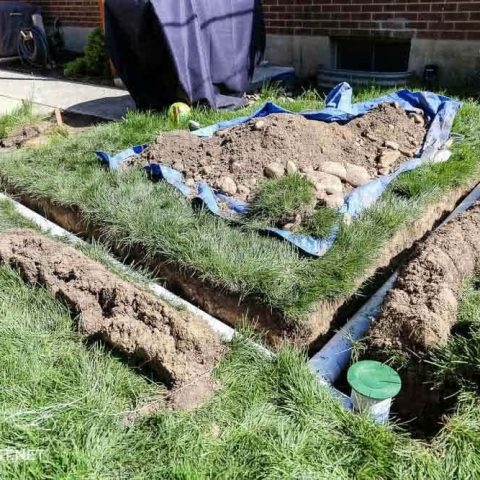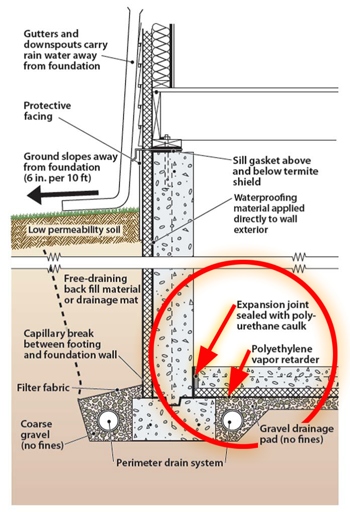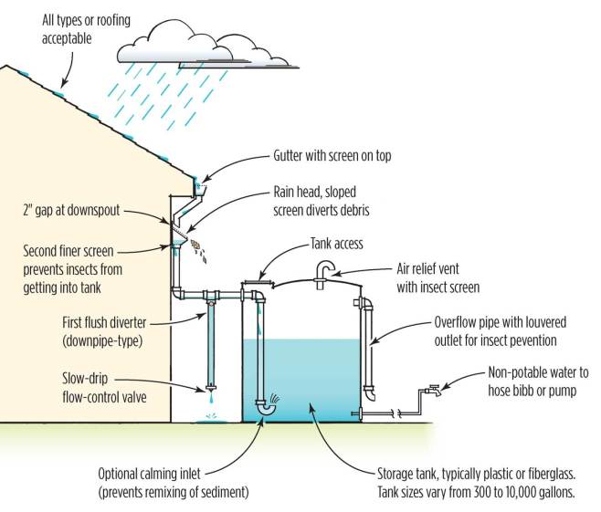Gutter water is often seen as a nuisance, but it actually plays an important role in our ecosystem. This water can end up in one of three places: underground, in a storm drain, or in a retention pond. Each of these places has a different purpose, but they all help to keep our environment clean.
Where Should Gutter Water Go?
Gutter water can go to three common places: onto your lawn, into a drainage system, or into the street.
How Is Gutter Water Directed Away From Your House?
Another way that gutter water is directed away from your house is through the use of a downspout. This type of guard sits on top of the gutter and helps to keep leaves and other debris from clogging the gutter and causing water to back up. Gutter water is directed away from your house in a few different ways. The downspout is a pipe that is connected to the gutter and extends down to the ground. One way is through the use of a gutter guard or leaf guard. This pipe helps to carry the water away from the house and prevents it from pooling around the foundation.
1 – Downspout Extensions
They are installed at the end of the gutter run and direct water away from the foundation of your home. Downspout extensions are a vital part of any gutter system. Without downspout extensions, water would simply pour off the edge of the gutter and onto the ground next to your home, causing extensive damage to your foundation.
2 – Buried Downspouts
If your downspouts are buried, that means the water from your gutters is being directed into a pipe that runs underground. This is a common way to direct gutter water away from your house, and it can be an effective way to keep your foundation from getting too wet.
However, there are a few things to keep in mind if you have buried downspouts. First, make sure that the pipe you’re using is big enough to handle the amount of water that your gutters will produce. If the pipe is too small, it could overflow and cause water to back up into your gutters.

Second, make sure the pipe is properly installed and that it slopes away from your house. If the pipe isn’t installed correctly, water could leak out and cause damage to your foundation or landscaping.
Finally, be sure to check your buried downspouts regularly to make sure they’re not clogged. If they are, the water from your gutters will have nowhere to go and could cause serious damage to your foundation.
3 – Buried Drain Pipes
This is a great way to keep the water away from your foundation and to prevent flooding. There are a few different ways that water can be directed away from your house when it comes from your gutters. These pipes are buried underground and they lead the water away from your house and into a different area. One way is to have buried drain pipes.
4 – Splash Blocks
Splash blocks are one of the most common ways to direct gutter water away from your house. They are typically made of concrete or plastic and are placed at the end of your gutter downspout to catch and redirect the flow of water. Splash blocks help to prevent erosion around your foundation and can also help to keep your landscaping looking its best by directing water away from flower beds and other areas where you don’t want it to pool.
5 – Storm Drains
They are connected to a system of pipes that carry the water to a nearby lake, river, or treatment plant. Storm drains are usually located at the edge of your property, in the street, or in a ditch. Storm drains are designed to direct runoff from rain and melting snow away from your home and Foundation.
6 – Downspouts Pipes
They are used to direct water away from your house and into a drainage system. Downspouts are pipes that are installed along the edge of your roof.
There are a few different types of downspouts, but the most common are the U-shaped pipes that are connected to the gutter system. These pipes are usually made of plastic or metal, and they come in a variety of sizes.
If you have a lot of trees on your property, you may need to install additional downspouts to ensure that all of the water is directed away from your house. Downspouts are typically installed at the corners of your house, but they can also be installed along the length of your roof.
Most homes have four-inch gutters, so the downspouts are typically two inches in diameter. The size of your downspouts will depend on the size of your gutters.
These brackets can be made of plastic or metal, and they come in a variety of sizes. Downspouts are typically installed using brackets that are screwed into the side of your house.

This can be done by running a pipe from the downspout to a drainage ditch, or by connecting the downspout to a French drain. Once the downspouts are installed, you will need to connect them to a drainage system.
If you live in an area that is prone to flooding, you may want to consider installing a backflow preventer on your downspouts. This device will allow water to flow out of your gutters, but it will prevent water from flowing back into your house.
If you have any questions about downspouts, or if you need help installing them, contact a professional gutter contractor today. Downspouts are an important part of your gutter system, and they play a vital role in directing water away from your house.
7 – Downspout Connectors (StealthFlow)
The downspouts are installed at the corners of your house and are connected to the gutter system with a series of connectors. The connectors allow the water to flow from the gutters into the downspouts and away from your house. Gutter water is directed away from your house through a system of downspouts and connectors.
Where Do Downspouts Drain?
Most often, downspouts are connected to the home’s gutter system and are used to direct water away from the foundation of the home. In some cases, downspouts are simply directed away from the home. Downspouts can be connected to a home’s sewer system, or they can be connected to a dry well. In this section, we’ll be discussing where downspouts drain.
1 – Drainage Pit
The pit is usually lined with gravel or other material to prevent erosion and to keep the water from seeping into the ground. A drainage pipe is then installed from the gutter or downspout to the pit in order to direct the water into it. A drainage pit is a hole or pit that is dug in order to catch and collect water that has drained from a roof or other surface.
It can also be allowed to evaporate or seep into the ground, depending on the location of the pit and the soil conditions. The water that collects in the pit can then be redirected to a different location, such as a storm sewer or a dry well.

You should also check it regularly to make sure that the water is draining properly and that there is no water build-up. If you notice any problems, you should contact a professional to have the pit cleaned or repaired. If you have a drainage pit on your property, it is important to keep it clear of debris so that it can function properly.
2 – Rainwater Collection System
There are a few different places that rainwater from your gutters can drain. The water is collected in a tank or barrels and can be used for watering plants or washing your car. One is into a rainwater collection system, which is a great way to save water for later use!

This is called infiltration and it is a great way to help recharge the groundwater supply. Another place that rainwater can drain is directly into the ground.
This is the system of pipes that carries water away from homes and businesses during a storm. The last place that rainwater can go is into the storm sewer system. The water is then discharged into a nearby body of water, such as a river or lake.
3 – Rain Barrel
If your home has a rain barrel, that’s where your downspout water will go! This water can then be used for watering your plants, washing your car, or even cleaning your gutters! A rain barrel is a container that collects and stores rainwater from your roof.
Frequently Asked Questions
1. What are the three common places that gutter water goes?
2. How does gutter water get into the storm drain?
3. How does gutter water get into the groundwater?
4. How does gutter water get into the sewer system?
5. How can I prevent gutter water from getting into the sewer system?
6. How can I prevent gutter water from getting into the groundwater?
7. What are the consequences of gutter water getting into the sewer system?
8. What are the consequences of gutter water getting into the groundwater?
9. What are some things I can do to reduce the amount of gutter water?
10. What are some things I can do to prevent gutter water from getting into the storm drain?
1. What are the three common places that gutter water goes?
Gutter water can go into the storm drain, the groundwater, or the sewer system.
2. How does gutter water get into the storm drain?
Gutter water can get into the storm drain through an opening in the curb or through a catch basin.
3. How does gutter water get into the groundwater?
Gutter water can get into the groundwater through cracks in the pavement or through the soil.
4. How does gutter water get into the sewer system?
Gutter water can get into the sewer system through the storm drain or through the groundwater.
5. How can I prevent gutter water from getting into the sewer system?
You can prevent gutter water from getting into the sewer system by redirecting it to a different location, such as a rain barrel or a dry well.
6. How can I prevent gutter water from getting into the groundwater?
You can prevent gutter water from getting into the groundwater by redirecting it to a different location, such as a rain barrel or a dry well.
7. What are the consequences of gutter water getting into the sewer system?
The consequences of gutter water getting into the sewer system can include flooding, water pollution, and the spread of diseases.
8. What are the consequences of gutter water getting into the groundwater?
The consequences of gutter water getting into the groundwater can include flooding, water pollution, and the spread of diseases.
9. What are some things I can do to reduce the amount of gutter water?
Some things you can do to reduce the amount of gutter water include cleaning your gutters regularly and installing a gutter guard.
10. What are some things I can do to prevent gutter water from getting into the storm drain?
Some things you can do to prevent gutter water from getting into the storm drain include redirecting it to a different location and cleaning your gutters regularly.
Final thoughts
There are three common places that gutter water goes: down the storm drain, into a retention pond, or into the ground. Each place has its own benefits and drawbacks. The storm drain is the fastest way to get rid of gutter water, but it can cause flooding if there is a lot of rain. The retention pond is a good way to reuse the water, but it can attract mosquitoes. The ground is the slowest way to get rid of the water, but it is the most natural way and it doesn’t have any negative effects.
